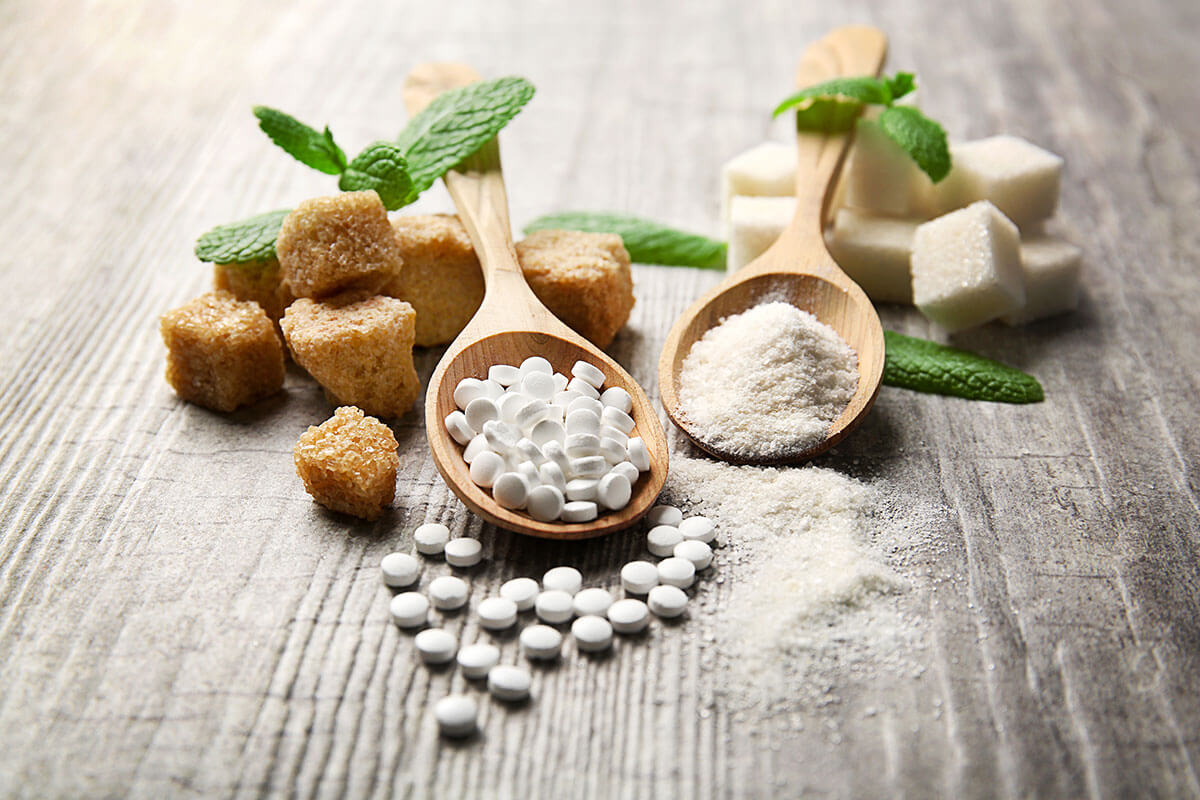Originally published in the Winter 2020 issue of American Fitness Magazine.
American consumers today have a multitude of options when it comes to choosing low- or no-calorie sweeteners to cut down on sugar and carbs. For those who favor natural products over artificial ones, honey and agave are far from the only options on the supermarket shelves today. In fact, more and more products are being made with a plant-based sweetener called stevia.

Stevia is not a new substance, however. Indigenous peoples of its native South America were using it to sweeten foods and medicines even before the 16th century (Misra et al. 2011). Although there are several species of stevia, Stevia rebaudiana is the one that contains rebaudioside A—the sweetest component of the stevia leaf, 200–300 times sweeter than table sugar (Prakash, Markosyan & Bunders 2014; Prakash et al. 2008). Today, most U.S. products made with stevia are sweetened with a highly purified extract of rebaudioside A.
If you want to learn even more about topics like the health effects of Stevia - and other additives - learn about nutrition with our selection of courses today!
how new is stevia?
Stevia is relatively new in the United States, having only recently gained approval from the U.S. Food and Drug Administration. Initial reports in 1991 suggested it might cause cancer, but those were soon refuted. In 1994, the Dietary Supplement Health and Education Act permitted stevia to be used as a dietary supplement (e.g., in packets as a coffee sweetener) but not as a food additive (McCaleb 1997).
Finally, in 2008, after appeals by food manufacturers, the FDA declared highly purified rebaudioside A extract (sometimes referred to as rebiana) to be “Generally Recognized as Safe” and approved its use in mainstream U.S. food production (Prakash et al. 2008).
Today, stevia is used in prepared products and comes in both packets for personal use and larger pouches for cooking and baking. When a recipe calls for sugar, a conversion chart can help cooks calculate how much stevia to substitute without oversweetening the food.
Why is stevia gaining in popularity, and how does it fit into a healthy diet? Read on for a summary of research and some guidelines to consider when discussing natural sweeteners with clients.
STEVIA: FROM FARM TO TABLE
Stevia typically refers to sweeteners in powder or liquid form that are made from dried stevia leaves. While the word stevia refers to the entire plant, only some components of the stevia leaf are sweet, and they need to be extracted by a multistep process.
TYPES OF STEVIA PRODUCTS
Some people with a green thumb can probably grow stevia at home, but most commonly, stevia leaves are commercially prepared. In either case, the leaves are harvested, dried and steeped in hot water. Then, they undergo several stages of filtration, and the dried plant material is rendered into a powder or liquid.
Green-leaf stevia—which comes in powder form—is the least processed. This is the type that has been used in South America for centuries as a natural sweetener and health remedy. Green-leaf stevia is only about 10–15 times sweeter than sugar (Savita et al. 2004; ScienceDirect 2019).
Purified stevia extracts are readily available in the grocery store. Per the FDA standards set forth in 2008, these extracts must contain 95% or more pure rebaudioside A glycosides and may not contain other forms of rebaudiosides or steviosides, in order to be legally marketed as food (FDA 2018).
INGREDIENTS ADDED TO STEVIA
Sometimes manufacturers will add other ingredients to stevia to produce a better-tasting sweetener. For example, Stevia in the Raw (developed by In the Raw) adds dextrose or maltodextrin, Truvia (developed jointly by The Coca-Cola Company and Cargill) adds erythritol, and Pure Via
(developed by Pepsico and Whole Earth Sweetener Co.) adds dextrose and erythritol.
CARBS, CALORIES AND THE GLYCEMIC INDEX
The glycemic index for sweeteners such as stevia is determined by the amount of carbohydrate present. Stevia is considered calorie-free because it has less than 5 grams of carbohydrate per serving. Stevia also has a glycemic index and glycemic load of zero.
While some animal studies have noted that artificial sweeteners (e.g., aspartame, saccharin and sucralose) might induce metabolic changes that increase the risks of type 2 diabetes, obesity and cardiovascular disease, stevia was not found to have a negative effect on glucose homeostasis. In fact, human studies have shown that stevia has beneficial effects on blood glucose and insulin levels (Gregersen et al. 2004). Unlike artificial sweeteners and sugar, stevia can suppress glucose levels and increase glucose tolerance to potentially stabilize blood sugar levels (Healthline 2019).
SAFETY, SIDE EFFECTS AND ALLERGIC REACTIONS of stevia
1. SAFETY CONSIDERATIONS
Stevia continues to be the focus of research, with new information emerging all the time. For example, a 2016 study found that stevia—which is steroidal in structure—increased progesterone production in sperm, leading researchers to question its possible role as an endocrine disruptor (Shannon 2016). For those on prescription medicines or with chronic health conditions, it’s best to consult with a physician or registered dietitian before making dietary changes.
2. POTENTIAL SIDE EFFECTS
Like various other foods, stevia may trigger symptoms in people with a sensitivity or allergy. Those who are sensitive to sugar alcohols may experience GI symptoms such as gas, bloating and diarrhea (Huizen 2017).
3. ALLERGY SYMPTOMS
The stevia plant is part of the Asteraceae family, which also counts ragweed, goldenrod and other potent allergen-producing plants among its members. However, the few case studies of people allergic to stevia date from before 2008, when today’s highly purified forms hit the market (Urban, Carakostas & Taylor 2015).
STEVIA’S ACCEPTABLE DAILY INTAKE
The acceptable daily intake (ADI) of a food is the maximum amount the FDA considers safe to consume each day over the course of a lifetime, and those numbers are set at very conservative levels. For stevia glycosides, the ADI is 4 milligrams per kilogram of body weight. This number is based on steviol glycosides with a purity of at least 95%, which is currently the only form approved for sale in the United States as a food additive or dietary supplement (Huizen 2017).
Although the FDA generally considers these sugar substitutes to be safe, it is still best to consume them in moderation. With more and more options to choose from, selecting a low- or no-calorie sweetener can be a challenge for health-conscious consumers (see “Having a ‘Sweet Talk’ With Clients,” below). Whether something is a good choice or not often depends on the outcome being assessed. Perhaps, and only perhaps, the best remedy is to use and not abuse. Now, that’s food for thought!
HAVING A “SWEET TALK” WITH CLIENTS
As fitness professionals, we are often a sounding board for our clientele. In general, here are some considerations to review with clients who are looking for a low- or no-calorie alternative to sugar:
INTENDED USE
Many sugar substitutes do not withstand high temperatures. If you are baking, for example, it is important to select options that are intended for this type of use. (This is usually indicated on product packaging.)
PRICE
Some sugar substitutes are expensive, whereas others have a cost closer to that of table sugar. Shopping around or buying in bulk may help you find lower prices.
AVAILABILITY
Some sugar substitutes are more widely available than others.
TASTE
Some people find that stevia has a bitter aftertaste. Clients may need to try several different options before they find a sweetener they like.
SIDE EFFECTS
Most people do well with stevia, but remind clients that it is important to listen to their body. Stevia is an herb, and people’s bodies may react differently to it—and to other sweeteners, for that matter.
NATURAL VERSUS ARTIFICIAL
Some people prefer using natural sweeteners, such as stevia, rather than artificial sugar substitutes. However, natural does not always mean lower-calorie or more healthful. With low-calorie sweeteners, as with any type of food, consuming in moderation is generally the best approach.
GIVE PROPER ADVICE TO CLIENTS
Do you know how to answer your clients’ nutrition questions? Be prepared with the most comprehensive nutrition program available—the NASM Certified Nutrition Coach (NASM-CNC). In this interactive program, you’ll learn how to put your clients on the healthiest path toward their best selves.
As an NASM-CNC, you’ll gain the relevant knowledge and abilities you’ll need to design and deliver top-quality, individualized nutrition coaching. In addition, you will:
- receive the latest cutting-edge science in all things related to fat loss, muscle gain and overall wellness;
- learn the psychology behind how people get stuck in dietary patterns;
- enjoy an industry-leading, immersive experience; and
- acquire the skills to apply nutrition science and behavior change to get results.
REFERENCES
Barriocanal, L.A., et al. 2008. Apparent lack of pharmacological effect of steviol glycosides used as sweeteners in humans. A pilot study of repeated exposures in some normotensive and hypotensive individuals and in type 1 and type 2 diabetics. Regulatory Toxicology and Pharmacology, 51 (1), 37–41.
FDA (U.S. Food & Drug Administration). 2018. Additional information about high-intensity sweeteners permitted for use in food in the United States. Accessed Oct. 29, 2019: fda.gov/food/food-additives-petitions/additional-information-about-high-intensity-sweeteners-permitted-use-food-united-states.
Gregersen, S., et al. 2004. Antihyperglycemic effects of stevioside in type 2 diabetic subjects. Metabolism, 53 (1), 73–76.
Healthline. 2018. The best sugar substitutes for people with diabetes. Accessed Oct. 18, 2019: healthline.com/health/type-2-diabetes/diabetes-stevia.
Huizen, J. 2017. Does stevia have any side effects? MedicalNewsToday. Accessed Oct. 18, 2019: medicalnewstoday.com/articles/319837.php.
ISC (International Stevia Council). n.d. Stevia leaf extract side effects. Accessed Oct. 4, 2019: internationalsteviacouncil
.org/index.php?id=195.
McCaleb, R. 1997. Controversial products in the natural foods market. The Herb Research Foundation. Accessed Oct. 4, 2019: herbs.org/greenpapers/controv.html.
Misra, H., et al. 2011. Antidiabetic activity of medium-polar extract from the leaves of Stevia rebaudiana Bert. (Bertoni) on alloxan-induced diabetic rats. Journal of Pharmacy and Bioallied Sciences, 3 (2), 242–48.
Prakash, I., et al. 2008. Development of rebiana, a natural, non-caloric sweetener. Food and Chemical Toxicology, 46 (7, Suppl.), S75–82.
Prakash, I., Markosyan, A., & Bunders, C. 2014. Development of next generation stevia sweetener: Rebaudioside M. Foods, 3 (1), 162–75.
Savita, S.M., et al. 2004. Stevia rebaudiana—A functional component for food industry. Journal of Human Ecology, 15 (4), 261–64.
ScienceDirect. n.d. Rebaudioside A. Accessed Oct.18, 2019: sciencedirect.com/topics/agricultural-and-biological-sciences/rebaudioside-a.
Shannon, M., et al. 2016. In vitro bioassay investigations of the endocrine disrupting potential of steviol glycosides and their metabolite steviol, components of the natural sweetener stevia. Molecular and Cellular Endocrinology, 427, 65–72.
Urban, J.D., Carakostas, M.C., & Taylor, S.L. 2015. Steviol glycoside safety: Are highly purified steviol glycoside sweeteners food allergens? Food and Chemical Toxicology, 75, 71–78.
















